Do you have a question about the Triumph Thruxton TFC 2019 and is the answer not in the manual?
Explains symbols used for important information and safety alerts.
Describes the meaning of warning symbols and their placement on the motorcycle.
Advises on maintenance by authorized Triumph dealers for optimal performance.
Outlines regulations and prohibited actions regarding noise control systems.
Covers compliance with FCC rules and operational conditions for these systems.
Declares compliance of fitted tires with relevant automotive vehicle standards.
Emphasizes the handbook as a permanent part and guides riders on its importance.
Encourages customer feedback and provides channels for communication with Triumph.
Details the motorcycle's design purpose and load limitations for safe operation.
Provides critical safety warnings regarding gasoline flammability and exhaust fume toxicity.
Specifies essential protective gear requirements for rider and passenger safety.
Offers instructions and warnings for safely parking the motorcycle to prevent accidents.
Warns against non-approved parts and modifications affecting safety and performance.
Advises on correct installation and functioning of legal equipment and systems.
Covers essential riding practices, including fatigue, drugs, licensing, and defensive riding.
Explains stability issues like weave and wobble and provides methods to manage them.
Highlights the importance of maintaining control via handlebars and using footrests.
Explains the function and wear limits of bank angle indicators for safe cornering.
Details the location of the VIN stamped on the frame and associated label.
Identifies the location where the engine serial number is stamped on the crankcase.
Illustrates warning labels and cross-references them to specific handbook sections.
Provides further details on specific warning labels and their meanings.
Identifies major external components of the motorcycle via numbered diagrams.
Continues the identification of motorcycle components with numbered diagrams.
Identifies the various controls and switches located on the handlebars.
Details the function and illumination of various warning lights on the instrument panel.
Describes the instrument panel, gauges, and displays like speedometer, tachometer, fuel gauge.
Explains the system for selecting riding modes and their effects on performance.
Covers the operation, settings, and disabling procedures for the Traction Control system.
Details the operation of the ignition switch, steering lock, and security precautions.
Explains the function and operation of the motorcycle's engine immobiliser system.
Provides information on the ignition key, its features, and important precautions.
Details the function of switches located on the right handlebar, including start/stop.
Explains the functions of switches on the left handlebar, such as SCROLL and MODE buttons.
Provides a detailed diagram identifying each element of the motorcycle's instrument panel.
Explains the MIL, its illumination conditions, and recommended actions for faults.
Describes the low oil pressure warning light and the immediate actions required.
Details the high coolant temperature warning light and procedures for overheating.
Explains the indicator light for the immobiliser system and potential malfunctions.
Describes the ABS warning light, its normal operation, and fault indications.
Explains the TC indicator light's function in active and inactive states.
Details when the TC disabled warning light illuminates and its implications.
Describes the operation of the turn signal switch and its indicator lights.
Explains the illumination of the high beam warning light when the high beam is selected.
Details the operation of DRLs and their corresponding warning light illumination.
Explains the neutral indicator light and its illumination when the transmission is in neutral.
Indicates when the low fuel warning light illuminates based on remaining fuel.
Describes the function of the speedometer for road speed and odometer for distance travelled.
Explains the tachometer's display of engine speed and warnings about the red zone.
Details how the gear position display indicates the engaged gear or neutral status.
Explains the fuel gauge's indication of fuel level and the low fuel warning light.
Describes the indication of predicted distance that can be traveled on remaining fuel.
Explains the display of average fuel consumption and its update conditions.
Details the function of trip meters for tracking distance travelled since reset.
Explains how to access and view the motorcycle's clock display.
Provides instructions and warnings for adjusting the motorcycle's clock time.
Explains the system for selecting riding modes and their effects on performance.
Details the procedure for selecting riding modes when the motorcycle is stationary.
Provides guidelines and warnings for selecting riding modes while the motorcycle is in motion.
Explains the TC system, its operation, and how it helps maintain traction.
Advises against adjusting TC settings while moving and covers default behaviour.
Outlines the steps required to disable the Traction Control system.
Details the operation of the ignition switch, steering lock, and security precautions.
Describes the four positions of the key-operated ignition switch and their functions.
Explains how the engine immobiliser system is activated and deactivated.
Provides information on the ignition key, its features, and important precautions.
Details the function of switches located on the right handlebar, including start/stop.
Explains the emergency use of the STOP position on the engine start/stop switch.
Describes the RUN position required for the motorcycle to operate.
Explains the operation of the electric starter via the START position.
Details how to activate and deactivate the hazard warning lights.
Explains the functions of switches on the left handlebar, such as SCROLL and MODE buttons.
Explains the use of the SCROLL button for operating instrument functions.
Describes the operation of the horn button and when the horn sounds.
Explains how to operate the turn signal switch and cancel indicators.
Details the function of the MODE button for selecting riding modes.
Explains the manual operation of DRLs using the dedicated switch.
Describes how to activate the high beam and switch between dip and high beams.
Details the electronic throttle system, its operation, and potential malfunction indicators.
Explains the adjustment of the brake lever span and ratio for rider preference.
Details the adjustment of the clutch lever span for optimal engagement.
Covers fuel grade, ethanol compatibility, and engine calibration recommendations.
Provides critical safety instructions and precautions to be followed during refueling.
Details the procedure for opening, closing, and locking the fuel tank cap.
Offers warnings and instructions on how to safely fill the fuel tank without overfilling.
Explains the motorcycle's side stand, interlock system, and parking safety.
Describes how to remove and reinstall the side panels for access to components.
Mentions the contents of the tool kit and its location.
Covers the seat stand and precautions for handling the seat.
Explains the purpose and installation of the seat cover.
Details the seat lock mechanism and warnings about securing the seat properly.
Provides step-by-step instructions for removing and reinstalling the motorcycle seat.
Explains the location and function of the USB socket for charging electronic devices.
Guides on the critical engine breaking-in process to ensure longevity and performance.
Lists essential daily checks to ensure safe and reliable motorcycle operation.
Provides an overview of fundamental riding procedures and safety.
Details the correct procedures for stopping the motorcycle engine safely.
Outlines the steps and safety precautions for starting the motorcycle engine.
Explains the correct technique for moving off smoothly from a stationary position.
Guides on the process of shifting gears, including safety warnings for downshifting.
Covers essential braking techniques, including applying brakes and emergency braking.
Explains how the ABS system works, its benefits, and potential limitations.
Provides comprehensive instructions and warnings for safely parking the motorcycle.
Warns against installing accessories that impair control or affect motorcycle operation.
Provides guidelines on weight distribution, securing loads, and maximum payload limits.
Emphasizes the importance of scheduled maintenance and warns against incorrect procedures.
Presents a detailed table outlining maintenance tasks based on mileage or time intervals.
Details engine oil level inspection, oil and filter changes, and proper disposal.
Covers coolant level inspection, adjustment, and the importance of corrosion inhibitors.
Addresses throttle control operation, inspection, and warnings about sticking throttles.
Explains clutch inspection, adjustment, and the impact of lever free play.
Covers drive chain lubrication, inspection, adjustment, and wear checks.
Details brake pad inspection, replacement, and the break-in process for new pads and discs.
Discusses how brake pad wear is compensated and the importance of brake system integrity.
Explains the hygroscopic nature of brake fluid and its replacement requirements.
Provides instructions for checking and adjusting the front brake fluid level.
Details the procedure for inspecting and adjusting the rear brake fluid level.
Explains the operation of brake light switches and troubleshooting for defects.
Offers guidance on adjusting mirrors for optimal rearward vision and safety.
Covers inspection of steering head bearings and wheel bearings for play and wear.
Details front suspension settings, preload adjustment, and damping adjustments.
Covers rear suspension settings, preload, and damping adjustments.
Provides crucial information on tire types, inflation pressures, wear, and replacement.
Covers battery maintenance, charging, removal, installation, and safety precautions.
Explains the function of fuses, how to identify blown fuses, and replacement procedures.
Details headlight adjustment, beam settings, and warnings about covering the lens.
Emphasizes regular cleaning for maintaining the motorcycle's appearance and condition.
Outlines precautions to protect specific areas of the motorcycle before washing.
Provides instructions for washing the motorcycle using appropriate cleaners and techniques.
Details steps to take immediately after washing, including brake checks and drying.
Advises on cleaning, drying, and polishing gloss paintwork to maintain its finish.
Provides specific care instructions for matt paintwork, avoiding polishes and waxes.
Guides on cleaning unpainted or un-lacquered aluminum components to preserve appearance.
Explains the regular cleaning required for chrome and stainless steel parts to prevent deterioration.
Provides specific cleaning advice for black chrome parts to maintain their appearance.
Details the cleaning procedure for exhaust systems made of various materials.
Offers recommendations for cleaning and maintaining the leather seat for longevity.
Provides general instructions for cleaning and caring for other leather products.
Gives instructions and warnings for cleaning the motorcycle's windshield safely.
States where to find model-specific dimensions, weights, and performance figures.
Specifies the maximum payload capacity for the motorcycle.
Lists key engine specifications, including type, displacement, and firing order.
Provides details on the lubrication system and engine oil capacities.
Lists specifications for the cooling system, including coolant type and capacity.
Details specifications for the electronic fuel injection system.
Lists fuel type, octane rating, and tank capacity.
Provides specifications for the ignition system, including spark plug type and gap.
Lists transmission specifications, including type, clutch, and gear ratios.
Specifies tire sizes and recommended cold inflation pressures for front and rear tires.
Lists specifications for electrical components like battery, alternator, and lights.
Provides frame specifications such as rake and trail.
Lists critical tightening torque values for various motorcycle components.
Specifies recommended fluids and lubricants for bearings, brake fluid, coolant, and engine oil.
Explains symbols used for important information and safety alerts.
Describes the meaning of warning symbols and their placement on the motorcycle.
Advises on maintenance by authorized Triumph dealers for optimal performance.
Outlines regulations and prohibited actions regarding noise control systems.
Covers compliance with FCC rules and operational conditions for these systems.
Declares compliance of fitted tires with relevant automotive vehicle standards.
Emphasizes the handbook as a permanent part and guides riders on its importance.
Encourages customer feedback and provides channels for communication with Triumph.
Details the motorcycle's design purpose and load limitations for safe operation.
Provides critical safety warnings regarding gasoline flammability and exhaust fume toxicity.
Specifies essential protective gear requirements for rider and passenger safety.
Offers instructions and warnings for safely parking the motorcycle to prevent accidents.
Warns against non-approved parts and modifications affecting safety and performance.
Advises on correct installation and functioning of legal equipment and systems.
Covers essential riding practices, including fatigue, drugs, licensing, and defensive riding.
Explains stability issues like weave and wobble and provides methods to manage them.
Highlights the importance of maintaining control via handlebars and using footrests.
Explains the function and wear limits of bank angle indicators for safe cornering.
Details the location of the VIN stamped on the frame and associated label.
Identifies the location where the engine serial number is stamped on the crankcase.
Illustrates warning labels and cross-references them to specific handbook sections.
Provides further details on specific warning labels and their meanings.
Identifies major external components of the motorcycle via numbered diagrams.
Continues the identification of motorcycle components with numbered diagrams.
Identifies the various controls and switches located on the handlebars.
Details the function and illumination of various warning lights on the instrument panel.
Describes the instrument panel, gauges, and displays like speedometer, tachometer, fuel gauge.
Explains the system for selecting riding modes and their effects on performance.
Covers the operation, settings, and disabling procedures for the Traction Control system.
Details the operation of the ignition switch, steering lock, and security precautions.
Explains the function and operation of the motorcycle's engine immobiliser system.
Provides information on the ignition key, its features, and important precautions.
Details the function of switches located on the right handlebar, including start/stop.
Explains the functions of switches on the left handlebar, such as SCROLL and MODE buttons.
Provides a detailed diagram identifying each element of the motorcycle's instrument panel.
Explains the MIL, its illumination conditions, and recommended actions for faults.
Describes the low oil pressure warning light and the immediate actions required.
Details the high coolant temperature warning light and procedures for overheating.
Explains the indicator light for the immobiliser system and potential malfunctions.
Describes the ABS warning light, its normal operation, and fault indications.
Explains the TC indicator light's function in active and inactive states.
Details when the TC disabled warning light illuminates and its implications.
Describes the operation of the turn signal switch and its indicator lights.
Explains the illumination of the high beam warning light when the high beam is selected.
Details the operation of DRLs and their corresponding warning light illumination.
Explains the neutral indicator light and its illumination when the transmission is in neutral.
Indicates when the low fuel warning light illuminates based on remaining fuel.
Describes the function of the speedometer for road speed and odometer for distance travelled.
Explains the tachometer's display of engine speed and warnings about the red zone.
Details how the gear position display indicates the engaged gear or neutral status.
Explains the fuel gauge's indication of fuel level and the low fuel warning light.
Describes the indication of predicted distance that can be traveled on remaining fuel.
Explains the display of average fuel consumption and its update conditions.
Details the function of trip meters for tracking distance travelled since reset.
Explains how to access and view the motorcycle's clock display.
Provides instructions and warnings for adjusting the motorcycle's clock time.
Explains the system for selecting riding modes and their effects on performance.
Details the procedure for selecting riding modes when the motorcycle is stationary.
Provides guidelines and warnings for selecting riding modes while the motorcycle is in motion.
Explains the TC system, its operation, and how it helps maintain traction.
Advises against adjusting TC settings while moving and covers default behaviour.
Outlines the steps required to disable the Traction Control system.
Details the operation of the ignition switch, steering lock, and security precautions.
Describes the four positions of the key-operated ignition switch and their functions.
Explains how the engine immobiliser system is activated and deactivated.
Provides information on the ignition key, its features, and important precautions.
Details the function of switches located on the right handlebar, including start/stop.
Explains the emergency use of the STOP position on the engine start/stop switch.
Describes the RUN position required for the motorcycle to operate.
Explains the operation of the electric starter via the START position.
Details how to activate and deactivate the hazard warning lights.
Explains the functions of switches on the left handlebar, such as SCROLL and MODE buttons.
Explains the use of the SCROLL button for operating instrument functions.
Describes the operation of the horn button and when the horn sounds.
Explains how to operate the turn signal switch and cancel indicators.
Details the function of the MODE button for selecting riding modes.
Explains the manual operation of DRLs using the dedicated switch.
Describes how to activate the high beam and switch between dip and high beams.
Details the electronic throttle system, its operation, and potential malfunction indicators.
Explains the adjustment of the brake lever span and ratio for rider preference.
Details the adjustment of the clutch lever span for optimal engagement.
Covers fuel grade, ethanol compatibility, and engine calibration recommendations.
Provides critical safety instructions and precautions to be followed during refueling.
Details the procedure for opening, closing, and locking the fuel tank cap.
Offers warnings and instructions on how to safely fill the fuel tank without overfilling.
Explains the motorcycle's side stand, interlock system, and parking safety.
Describes how to remove and reinstall the side panels for access to components.
Mentions the contents of the tool kit and its location.
Covers the seat stand and precautions for handling the seat.
Explains the purpose and installation of the seat cover.
Details the seat lock mechanism and warnings about securing the seat properly.
Provides step-by-step instructions for removing and reinstalling the motorcycle seat.
Explains the location and function of the USB socket for charging electronic devices.
Guides on the critical engine breaking-in process to ensure longevity and performance.
Lists essential daily checks to ensure safe and reliable motorcycle operation.
Provides an overview of fundamental riding procedures and safety.
Details the correct procedures for stopping the motorcycle engine safely.
Outlines the steps and safety precautions for starting the motorcycle engine.
Explains the correct technique for moving off smoothly from a stationary position.
Guides on the process of shifting gears, including safety warnings for downshifting.
Covers essential braking techniques, including applying brakes and emergency braking.
Explains how the ABS system works, its benefits, and potential limitations.
Provides comprehensive instructions and warnings for safely parking the motorcycle.
Warns against installing accessories that impair control or affect motorcycle operation.
Provides guidelines on weight distribution, securing loads, and maximum payload limits.
Emphasizes the importance of scheduled maintenance and warns against incorrect procedures.
Presents a detailed table outlining maintenance tasks based on mileage or time intervals.
Details engine oil level inspection, oil and filter changes, and proper disposal.
Covers coolant level inspection, adjustment, and the importance of corrosion inhibitors.
Addresses throttle control operation, inspection, and warnings about sticking throttles.
Explains clutch inspection, adjustment, and the impact of lever free play.
Covers drive chain lubrication, inspection, adjustment, and wear checks.
Details brake pad inspection, replacement, and the break-in process for new pads and discs.
Discusses how brake pad wear is compensated and the importance of brake system integrity.
Explains the hygroscopic nature of brake fluid and its replacement requirements.
Provides instructions for checking and adjusting the front brake fluid level.
Details the procedure for inspecting and adjusting the rear brake fluid level.
Explains the operation of brake light switches and troubleshooting for defects.
Offers guidance on adjusting mirrors for optimal rearward vision and safety.
Covers inspection of steering head bearings and wheel bearings for play and wear.
Details front suspension settings, preload adjustment, and damping adjustments.
Covers rear suspension settings, preload, and damping adjustments.
Provides crucial information on tire types, inflation pressures, wear, and replacement.
Covers battery maintenance, charging, removal, installation, and safety precautions.
Explains the function of fuses, how to identify blown fuses, and replacement procedures.
Details headlight adjustment, beam settings, and warnings about covering the lens.
Emphasizes regular cleaning for maintaining the motorcycle's appearance and condition.
Outlines precautions to protect specific areas of the motorcycle before washing.
Provides instructions for washing the motorcycle using appropriate cleaners and techniques.
Details steps to take immediately after washing, including brake checks and drying.
Advises on cleaning, drying, and polishing gloss paintwork to maintain its finish.
Provides specific care instructions for matt paintwork, avoiding polishes and waxes.
Guides on cleaning unpainted or un-lacquered aluminum components to preserve appearance.
Explains the regular cleaning required for chrome and stainless steel parts to prevent deterioration.
Provides specific cleaning advice for black chrome parts to maintain their appearance.
Details the cleaning procedure for exhaust systems made of various materials.
Offers recommendations for cleaning and maintaining the leather seat for longevity.
Provides general instructions for cleaning and caring for other leather products.
Gives instructions and warnings for cleaning the motorcycle's windshield safely.
States where to find model-specific dimensions, weights, and performance figures.
Specifies the maximum payload capacity for the motorcycle.
Lists key engine specifications, including type, displacement, and firing order.
Provides details on the lubrication system and engine oil capacities.
Lists specifications for the cooling system, including coolant type and capacity.
Details specifications for the electronic fuel injection system.
Lists fuel type, octane rating, and tank capacity.
Provides specifications for the ignition system, including spark plug type and gap.
Lists transmission specifications, including type, clutch, and gear ratios.
Specifies tire sizes and recommended cold inflation pressures for front and rear tires.
Lists specifications for electrical components like battery, alternator, and lights.
Provides frame specifications such as rake and trail.
Lists critical tightening torque values for various motorcycle components.
Specifies recommended fluids and lubricants for bearings, brake fluid, coolant, and engine oil.
| Displacement | 1200 cc |
|---|---|
| Transmission | 6-speed |
| Frame | Tubular steel cradle |
| ABS | Yes |
| Fuel Capacity | 14.5 liters |
| Tires (Front) | 120/70 ZR17 |
| Tires (Rear) | 160/60 ZR17 |
| Engine Type | Liquid-cooled, 8 valve, SOHC, parallel twin |
| Rear Suspension | Ohlins twin shocks |
| Front Brakes | Twin 310mm floating discs, Brembo M50 4-piston radial monobloc calipers |
| Rear Brakes | Single 220 mm disc |
| Seat Height | 810 mm |
| Exhaust | Stainless steel with brushed finish |
| Limited Edition | Yes, limited to 750 units worldwide |
| Torque | 112 Nm |
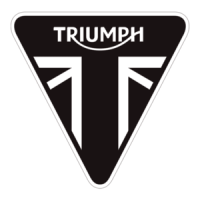



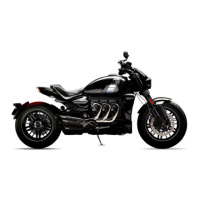
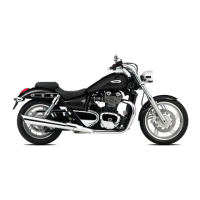
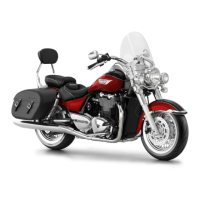




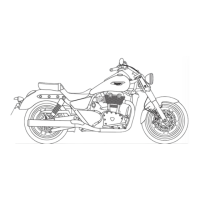
